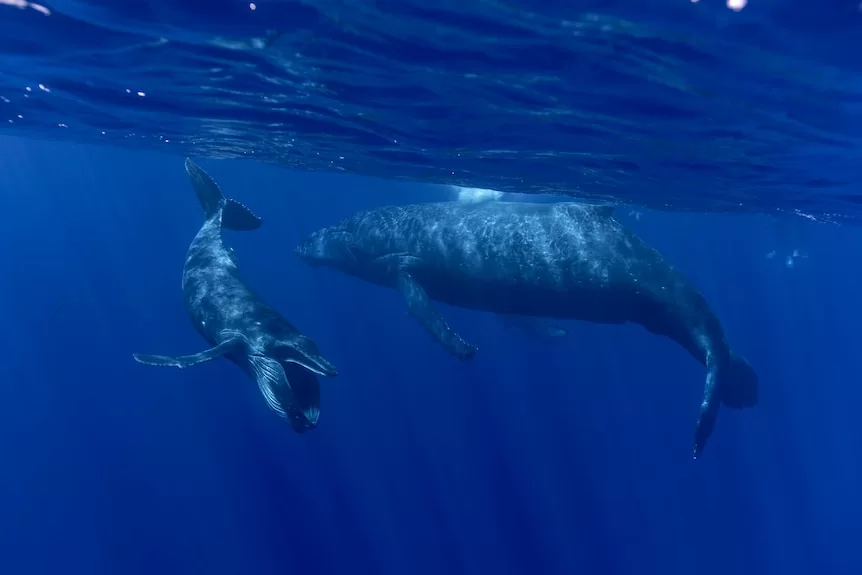- In short: A study published in Nature has found baleen whales have evolved over millions of years to use a modified voice box that generates sound without them choking.
- These marine mammals critically depend on “singing” to communicate with each other and attract mates.
- What’s next? Experts in the field say the new study is the “most comprehensive” analysis to date of the mechanics behind whale songs and will direct future research into how they communicate.
It is one of Earth’s most haunting sounds — the “songs” of baleen whales like the humpback can be heard over vast distances in the watery realm.
Scientists now think they have an idea about how these marine mammals do it, and it’s something not seen in other animals: a specialised voice box.
Experts say the discovery, while based on a sample size that is too small to be definitive, will direct future research into how whales communicate.
In a paper published in the Nature journal on Wednesday, a team led by Professor Coen Elemans from the University of Southern Denmark, studied the voice boxes, or larynxes, from three dead, stranded baleen whales — a humpback, minke and sei.
In the laboratory, the scientists blew air through the voice boxes under controlled conditions to see what tissues might vibrate.
They also developed a three-dimensional computer model of the whale larynx to simulate the effect of muscle contractions on sound.
Professor Elemans said whales evolved from land mammals roughly 50 million years ago, with the larynx modification allowing them to vocalise underwater while protecting their airways from choking and drowning.
“They are highly intelligent, social animals … they have the rare ability to learn new songs and spread their vocal culture across the planet,” he said.
“To communicate and find each other in murky and dark oceans, baleen whales depend critically on the production of sound. For example, humpback females and their calves communicate with each other by voice, and humpback males sing to attract females.”
Unlike humans and other mammals, baleen whales do not have teeth or vocal chords.
Instead, they have a U-shaped tissue in their voice boxes that allows them to breathe in massive amounts of air and a large “cushion” of fat and muscle not seen in other animal species.
Professor Elemans said the research team discovered when the whale exhales, this cushion vibrates from the airflow in an undulating motion, generating sound.
“This is the most comprehensive and significant study to date on how baleen whales vocalise, a long-standing mystery in the field,” said Jeremy Goldbogen, an associate professor of oceans at Stanford University, who was not involved in the new research.
He noted there was more to be studied “given the extraordinarily diverse acoustic repertoires” of whales. Humpbacks, for example, are known to compose elaborate songs that travel across oceans and whale pods.
But as loud as whale songs are, modelling suggests that humpbacks and related species cannot produce sounds louder than ships, Professor Elemans said.
“They’re really affected by [shipping noise] and it significantly reduces their ability to communicate,” he said. “There’s just no way for them to get louder.”
Because some whales sing as a mating call, the shipping industry’s interruption of those songs is potentially worrying, said Michael Noad, director of the Centre for Marine Science at the University of Queensland in Australia. He was not part of the Nature study.
“For whale populations that are really dispersed, like the Antarctic blue whales, they might not be able to find mates in a noisy ocean environment,” he said.
But he noted that whale species like humpbacks that gather in big numbers are more likely to shrug off such noise pollution.
Since the whale voice boxes tested in the recent study were from juveniles, whale expert Professor Joy Reidenberg said further experiments on adult males were needed to confirm the study’s findings.
But Professor Reidenberg, who works for the Centre for Anatomy and Functional Morphology at the Icahn School of Medicine in New York, noted that lab research is probably as close as we can get to replicating how whales sing.
“Right now, our technology involves sticking a scope into a whale to see what exactly is vibrating,” she said. “Since you’re never going to be able to do that in a wild animal, these experiments are the next best thing.”
Reuters/AP
